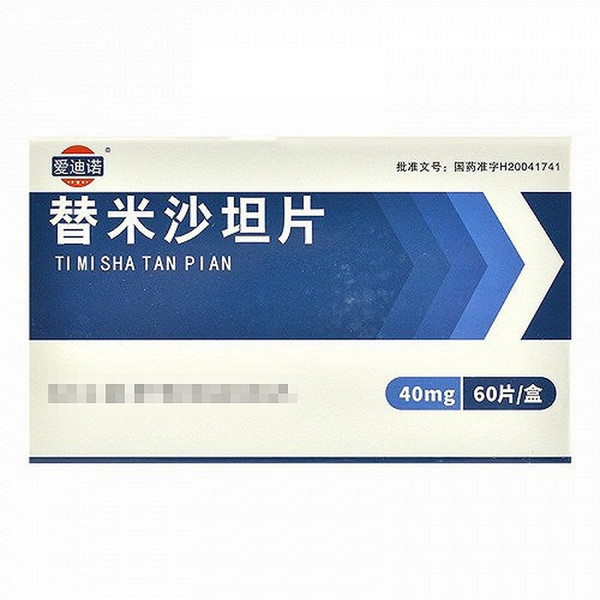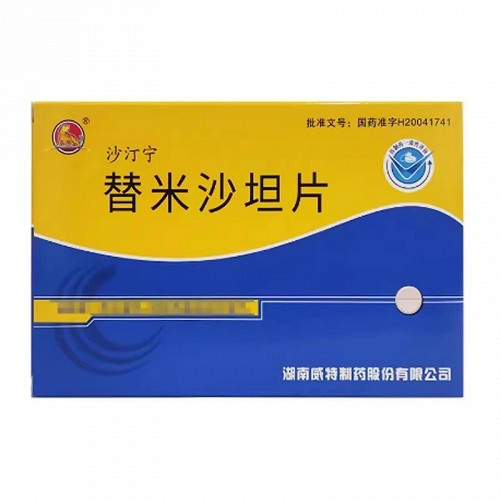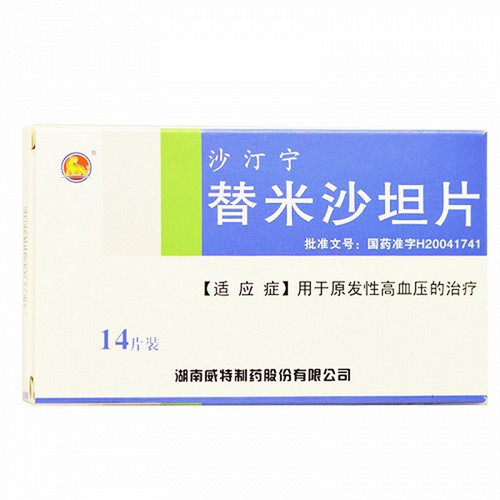Product Overview
[Drug Name]
Generic Name: Telmisartan Tablets
Trade Name: AiDiNuo Telmisartan Tablets 40mg*60 Tablets
Pinyin Full Code: AiDiNuo TiMiShaTanPian 40mg*60 Tablets
[Main Ingredient]
The main ingredient is telmisartan.
[Properties]
This product is a white or off-white tablet.
[Indications/Main Functions]
For the treatment of essential hypertension.
[Specifications]
40mg*60 tablets
[Dosage and Administration]
Oral. Initial dose: 1 tablet (40mg) once daily; maintenance dose: 1-2 tablets (40-80mg) once daily, adjusted according to physician's advice based on clinical response. Specific dosage is as follows: Adults: Dosing should be individualized. The usual initial dose is 1 tablet (40mg) once daily. Telmisartan's antihypertensive efficacy is dose-dependent within the 20-80mg dose range. If optimal blood pressure is not achieved after treatment, the dose may be increased, up to a maximum of 80 mg once daily. This product can be used in combination with thiazide diuretics, such as hydrochlorothiazide, which have a synergistic antihypertensive effect. Because telmisartan does not reach its maximum effect until four to eight weeks after the start of treatment, this consideration should be taken when increasing the dose. Patients with Renal Impairment: No dose adjustment is required for this product. Telmisartan is not eliminated through hemofiltration. Patients with Hepatic Impairment: No dose adjustment is required for this product. Telmisartan is not eliminated through hemofiltration. Patients with Hepatic Impairment: The daily dose should not exceed 40 mg. Elderly patients do not require dose adjustment. Children and Adolescents: Safety and efficacy data for this product have not been established for children and adolescents under 18 years of age.
[Adverse Reactions]
In placebo-controlled trials, the overall incidence of adverse events was similar for telmisartan (41.4%) and placebo (43.9%). The incidence of adverse events was not dose-related or associated with gender, age, or race. The following adverse reactions were reported in 578 hypertensive patients treated with telmisartan in clinical trials. Adverse reactions are categorized by frequency as follows: Very Common (>1/10); Common (>1/100, <1/10); Uncommon (>1/1000, <1/100); Rare (>1/10000, <1/1000); and Very Rare (<1/1000). Systemic Reactions: Common: Back pain (e.g., sciatica), chest pain, flu-like symptoms, and infectious symptoms (e.g., urinary tract infections including cystitis); Uncommon: Visual disturbances, hyperhidrosis. Central and Peripheral Nervous System: Common: Dizziness. Gastrointestinal System: Common: Abdominal pain, diarrhea, dyspepsia, and gastrointestinal disturbances; Uncommon: Dry mouth and flatulence. Musculoskeletal System: Common: Arthralgia, leg cramps or pain, myalgia; Rare: Tenosynovitis-like symptoms. Nervous System: Rare: Anxiety. Respiratory System: Common: Upper respiratory tract infections including pharyngitis and rhinitis. Skin and Appendages: Common: Skin abnormalities such as eczema. Additionally, since the marketing of telmisartan, individual case reports have included erythema, pruritus, syncope, insomnia, depression, stomach discomfort, vomiting, hypotension, bradycardia, tachycardia, dyspnea, granulocytosis, thrombocytopenia, weakness, and decreased work efficiency. Similar to other angiotensin II antagonists, rare cases have reported angioedema, urticaria, and other related adverse reactions. Laboratory Findings: Decreases in hemoglobin or increases in uric acid were rarely observed in the telmisartan treatment group compared to placebo. Elevations in blood creatinine or liver enzymes were similar to or lower in the telmisartan group than in the placebo group.
[Contraindications]
Allergies to the active ingredient or any of the excipients of this product; those in mid- to late-pregnancy or breastfeeding; patients with biliary obstructive disease; patients with severe hepatic insufficiency; and patients with severe renal insufficiency (creatinine clearance <30 ml/min).
[Drug Interactions]
Lithium: Concomitant use of lithium with angiotensin-converting enzyme inhibitors can cause reversible increases in blood lithium levels and toxic reactions. There have also been isolated cases of lithium combined with angiotensin I receptor antagonists. Therefore, caution should be exercised when lithium is used concomitantly with this product. If coadministration is necessary, blood lithium levels should be monitored during coadministration. Some drugs can affect blood potassium levels or cause hyperkalemia (such as ACE inhibitors, potassium-sparing diuretics, potassium supplements, potassium-containing salt substitutes, cyclosporine A, or other drugs such as heparin sodium); monitoring of blood potassium levels is recommended if this product is used concomitantly with these drugs. Based on experience with other drugs that affect the renin-angiotensin system, concomitant use of this product with these drugs may result in increases in blood potassium levels (see Precautions). Pharmacokinetic studies have investigated the interaction of this product with digoxin, warfarin, hydrochlorothiazide, glyburide, ibuprofen, paracetamol, amlodipine, and other drugs. Digoxin plasma concentrations may increase by 20% (up to 39% in some cases), so digoxin plasma concentrations should be monitored. This product may enhance the antihypertensive effect of other antihypertensive drugs. Other clinically significant interactions have not been confirmed. Based on their pharmacological properties, the following drugs may enhance the antihypertensive effect of antihypertensive drugs, including telmisartan: bahydrofen and amifostine. Additionally, alcohol, barbiturates, sedatives, hypnotics, or antidepressants may potentiate the orthostatic hypotensive effect. When co-administered with telmisartan, the Cmax of the simvastatin metabolite (simvastatin acid) is slightly increased (1.34-fold) and its elimination is accelerated.
[Precautions]
Hepatic Impairment: This product should not be used in patients with cholestasis, obstructive biliary disease, or severe hepatic impairment, as telmisartan is largely excreted via the bile, and clearance of this product may be reduced in these patients. This product should be used with caution in patients with mild to moderate hepatic impairment. Renovascular Hypertension: In patients with bilateral renal artery stenosis or stenosis of the renal artery of a single functioning kidney, the risk of severe hypotension and renal insufficiency may be increased with the use of medications that affect the renin-angiotensin-aldosterone system. Renal Insufficiency and Renal Transplant Patients: This product should not be used in patients with severe renal insufficiency (creatinine clearance <30 m/min, see Contraindications). For patients with renal insufficiency, serum potassium and creatinine levels should be monitored regularly during use of this product. There are no data on the use of this product in patients shortly after a recent renal transplant. Volume-Depleted Patients: In patients with volume depletion or hyponatremia due to strong diuretic therapy, salt restriction, nausea, or vomiting, administration of this drug, particularly after the first dose, may cause symptomatic hypotension. Therefore, serum sodium and volume levels should be corrected before using this drug. Other Conditions Related to Stimulation of the Renin-Angiotensin-Aldosterone System: In patients whose vascular tone and renal function depend primarily on the activity of the renin-angiotensin-aldosterone system (such as those with severe congestive heart failure or underlying renal disease including renal artery stenosis), the use of drugs that affect this system may cause acute hypotension, hyperazotemia, oliguria, or rarely, acute renal failure. Primary Aldosteronism: Antihypertensive drugs that inhibit the renin-angiotensin-aldosterone system are generally ineffective in patients with primary aldosteronism, and therefore this drug is not recommended for such patients. Aortic or mitral stenosis, obstructive hypertrophic cardiomyopathy: As with other vasodilators, this drug should be used with caution in patients with aortic or mitral stenosis or obstructive hypertrophic cardiomyopathy. Electrolyte Imbalance: Hyperkalemia: Use of drugs that affect the renin-angiotensin-aldosterone system may cause hyperkalemia, particularly in patients with renal impairment and/or heart failure, and diabetes mellitus. However, for patients at risk, serum potassium levels should be closely monitored while taking this drug. Based on experience with other drugs that affect the renin-angiotensin-aldosterone system, concomitant use of this drug with potassium-sparing diuretics, potassium supplements, potassium-containing salt substitutes, or other drugs that increase serum potassium levels, such as heparin, may increase serum potassium levels. Therefore, caution should be exercised when using this drug with this drug (see Drug Interactions). Other: Similar to angiotensin-converting enzyme inhibitors, the antihypertensive effect of this drug and other angiotensin antagonists is less in blacks than in other ethnic groups, possibly due to the higher prevalence of low renin levels in hypertensive individuals in blacks. As with other antihypertensive drugs, excessive blood pressure reduction can cause myocardial infarction or stroke in patients with ischemic heart disease or ischemic cardiovascular disease. Effects on Driving and Operating Machinery: The effects of this drug on driving and operating machinery have not been studied. However, caution is advised when driving or operating machinery, as antihypertensive therapy can sometimes cause dizziness and drowsiness.
[Pediatric Use]
Safety and efficacy data for this drug have not been established in children and adolescents under 18 years of age.
[Elderly Use]
No dose adjustment is required.
[Overdose]
No case reports of overdose have been reported. The most likely manifestations of telmisartan overdose are hypotension and tachycardia; bradycardia may also occur. Telmisartan cannot be eliminated by hemodialysis. In the event of an overdose, the patient should be closely observed and symptomatic and supportive care should be provided. Treatment should be tailored to the timing of administration and the severity of symptoms. Recommended measures include inducing vomiting and/or gastric lavage. Activated charcoal may be effective in treating overdose. Serum electrolytes and creatinine should be monitored closely. If hypotension occurs, the patient should lie supine and promptly replenish salt and fluids.
[Pharmacology and Toxicology]
1. Toxicology Studies: The doses used in preclinical safety studies, comparable to clinical therapeutic doses, caused decreases in erythrocyte indices (erythrocytes, hemoglobin, and hematocrit), altered renal hemodynamics (increased blood urea nitrogen and creatinine), and elevated serum potassium in normotensive animals. Renal tubular dilation and atrophy were observed in dogs. Gastrointestinal mucosal damage (erosions, ulcers, or inflammation) was also observed in rats and dogs. These adverse pharmacological reactions, as known from preclinical studies, are common to both angiotensin-converting enzyme inhibitors and angiotensin I antagonists and can be prevented with oral salt supplementation. Increased plasma renin activity and juxtaglomerular cell hypertrophy/proliferation were observed in both species. These changes are also common to angiotensin-converting enzyme inhibitors and other angiotensin I antagonists and are not clinically specific. Animal studies have shown potential adverse effects of telmisartan on postnatal development of fetuses, including weight loss, delayed eye opening, and increased mortality. No mutagenicity or related mutagenic activity was observed in in vitro studies, and no carcinogenicity was observed in studies in mice and rats. 2. Pharmacology: Telmisartan is an orally active, specific angiotensin I receptor (AT1) antagonist. It binds with high affinity to the AT1 subtype of the angiotensin I receptor (the known site of angiotensin I action). This binding is persistent, but there is no partial agonist dose effect. Since telmisartan increases angiotensin II levels, the potential for direct receptor overstimulation is unknown. Telmisartan does not inhibit human total plasma renin or block ion channels. Angiotensin-converting enzyme (AT-converting enzyme) can also degrade bradykinin. Since telmisartan does not inhibit angiotensin-converting enzyme (AT-converting enzyme), adverse effects due to enhanced bradykinin action are not expected. Telmisartan has no affinity for other receptors, including AT2 and other less characterized AT receptors whose functions are still unclear. In humans, administration of 80 mg of telmisartan almost completely inhibits the angiotensin-induced blood pressure increase, with the inhibitory effect persisting for 24 hours and still measurable after 48 hours. The antihypertensive effect becomes increasingly evident within 3 hours after the first dose of telmisartan. Maximum antihypertensive effect is achieved 4 weeks after the start of treatment and is maintained with long-term treatment. Ambulatory blood pressure monitoring shows that the antihypertensive effect persists for more than 24 hours after dosing, including the 4 hours before the next dose. This finding was confirmed in placebo-controlled clinical trials: the trough-to-peak ratio remained consistently above 80% after dosing with 40 mg and 80 mg of telmisartan. There is a clear dose-time dependence for return to baseline SBP. Data regarding DBP are conflicting. In patients with hypertension, telmisartan reduces both systolic and diastolic blood pressure without affecting heart rate. The antihypertensive effect of telmisartan is comparable to that of other leading antihypertensive drugs. (Clinical trials have compared telmisartan with amlodipine, atenolol, enalapril, hydrochlorothiazide, losartan, and lisinopril.) If telmisartan treatment is abruptly discontinued, blood pressure gradually returns to pre-treatment levels over several days, without rebound hypertension. In clinical trials directly comparing two antihypertensive drugs, the incidence of dry cough was significantly lower in patients treated with telmisartan than in those treated with angiotensin-converting enzyme inhibitors. The effectiveness of telmisartan in improving mortality and cardiovascular morbidity is currently unknown.









